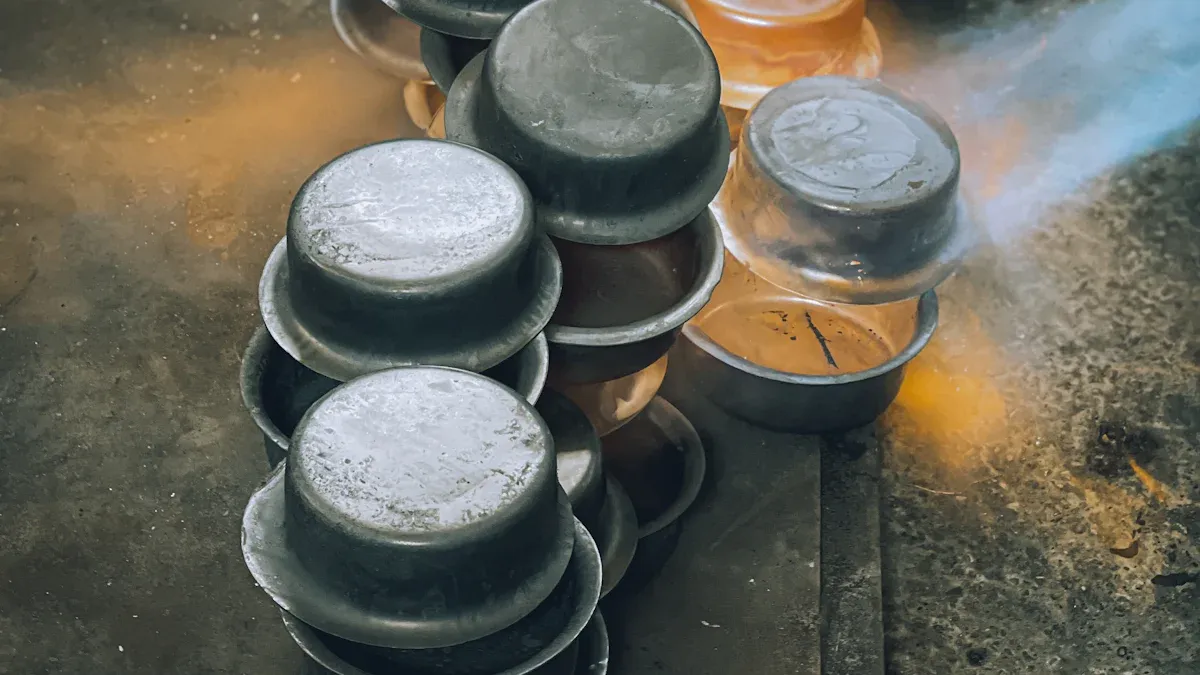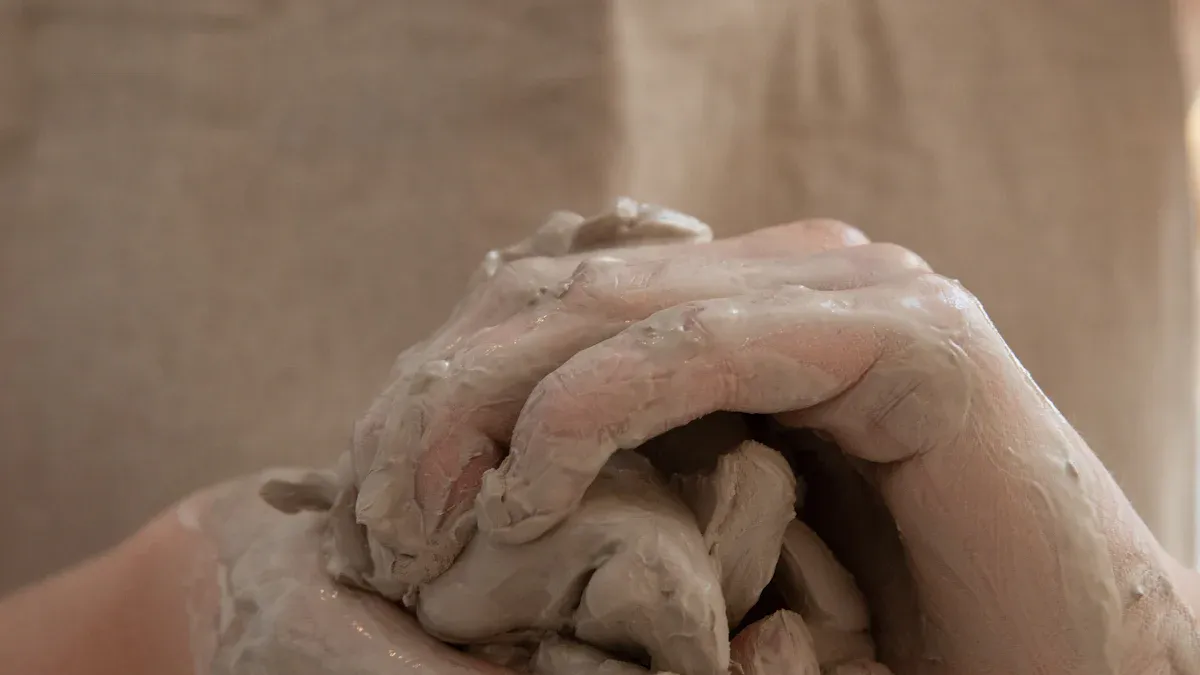
Extending the lifespan of your mold is essential for achieving operational efficiency and reducing costs. Every mold, especially an injection mold, requires consistent care to maintain optimal performance. Mold maintenance plays a critical role in this process. Cleaning, inspections, and timely repairs prevent wear and ensure durability, which ultimately helps to extend mold lifespan.
Proactive strategies also lead to measurable benefits. For example, a global manufacturer using COAST Systems’ mold management solution reduced unscheduled downtime by 45% in just one year. By proactively maintaining your mold, you can extend its lifespan by up to 20%, saving on repair costs and boosting mold performance. These efforts ensure your equipment operates at its best, delivering long-term value.
Several factors directly impact the lifespan of industrial molds. Understanding these factors helps you make informed decisions to extend mold lifespan and improve performance. Here are the key elements:
By focusing on these areas, you can significantly improve the durability of your molds and reduce the need for frequent replacements.
Injection molds face wear and tear, especially in high-volume production environments. The following table highlights common causes of mold wear and their effects:
| Cause of Wear | Description |
|---|---|
| High Pressure Areas | Wear occurs in transition sections and metering zones due to high pressure. |
| Metal-to-Metal Contact | Misalignment and mechanical issues lead to wear, even without high pressure. |
| Abrasive Fillers | Materials like glass fibers cause severe wear, influenced by particle shape and size. |
| Mixing Section Wear | Dispersion efficiency decreases due to wear in mixing designs and barrier flights. |
Understanding these causes allows you to take preventive measures and extend the injection mold lifespan.
Regular maintenance is essential for keeping your molds in top condition. Simple practices like cleaning, lubrication, and inspections can make a significant difference. Here’s how:
For example, implementing a quarterly cleaning schedule can increase the lifespan of your molds by up to 20%. Modern tools like laser scanning and thermal imaging provide detailed insights into mold conditions, enabling timely interventions. These practices ensure your molds remain efficient and durable, saving you time and money in the long run.

Proper mold maintenance and care are essential for extending mold lifespan and ensuring optimal performance. By focusing on cleaning, inspections, and storage, you can prevent damage, reduce downtime, and improve the durability of your molds. Below are the best practices for mold cleaning and maintenance.
Cleaning is a fundamental part of mold maintenance. It removes debris, contaminants, and residues that can cause wear or defects in your injection mold. Proper lubrication, on the other hand, minimizes friction and prevents mechanical damage. Here are some effective cleaning methods and lubrication tips:
Tip: Always follow the manufacturer’s recommendations for cleaning agents and lubricants to avoid compatibility issues.
By adopting these practices, you can significantly enhance the durability of your molds and reduce the risk of unscheduled stops.
Routine inspections are critical for identifying potential issues before they escalate into costly repairs. Regular maintenance inspections help you detect early signs of wear, such as cracks, scuffing, or misalignment. The following table highlights the benefits of routine inspections:
| Benefit | Explanation |
|---|---|
| Reduced repair costs | Early detection of issues prevents costly repairs later on. |
| Early detection of mold issues | Identifying problems before they escalate helps prevent mold growth. |
| Improved mold performance | Regular checks ensure molds operate at peak efficiency. |
In addition to these benefits, routine inspections also mitigate health risks. Airborne mold exposure can lead to respiratory issues, while skin irritation may occur from contact. By inspecting your molds regularly, you can address these risks and maintain a safe working environment.
Note: Aim to inspect your molds weekly or after every production run to catch problems early and extend mold lifespan.
Proper storage is just as important as cleaning and inspections when it comes to mold maintenance and care. Incorrect storage conditions can lead to rust, warping, or other forms of damage. Follow these best practices for proper storage:
Tip: Store molds in a clean, dry, and temperature-controlled environment to preserve their integrity and extend their lifespan.
By implementing these storage practices, you can protect your molds from damage and ensure they remain ready for use when needed.

Choosing the right material is crucial for creating a long-lasting injection mold. Materials with high durability can withstand repeated use, ensuring a longer lifespan. Steel is often the top choice due to its strength and ability to endure over a million cycles, making it ideal for large-scale production. Aluminum molds, while less expensive, wear out faster and are better suited for short production runs.
Different mold classes highlight the impact of material quality. For example, Class 101 molds last over 1,000,000 cycles, while Class 103 molds handle up to 500,000 cycles. This demonstrates how higher-quality materials directly enhance durability. When selecting materials, consider their physical and chemical properties to ensure they meet the demands of your production process.
Surface treatments significantly improve mold durability by reducing wear and corrosion. Coatings like diamond-chrome and hard chrome provide excellent abrasion resistance, making them ideal for molds used with glass-filled materials. Electroless nickel coatings offer superior chemical resistance, while nickel-P.T.F.E. coatings enhance lubricity and corrosion resistance.
The following table highlights the effectiveness of various surface treatments:
| Coating Type | Rockwell Hardness (R.C.) | Coefficient of Friction | Ideal Applications |
|---|---|---|---|
| Diamond-Chrome | 85+ | 0.15 or less | Abrasion resistance for moving components |
| Hard Chrome | 72 | 0.20 or less | Glass-filled material applications |
| Electroless Nickel | 50 | 0.45 or less | Excellent chemical resistance |
| Nickel-P.T.F.E. | 45 | 0.10 or less | Corrosion resistance and lubricity |
By applying the right surface treatment, you can extend the lifespan of your molds and reduce maintenance needs.
A well-designed mold not only improves performance but also extends its lifespan. Advanced CAD and CAE software allow you to simulate mold designs, optimizing geometry for better material flow and reduced stress. Adjustments to cooling channels and gates minimize defects and material waste, ensuring consistent production quality.
Finite Element Analysis (FEA) is another powerful tool. It predicts stress and temperature distribution, helping you identify potential weak points in the mold. Closed-loop control systems further enhance durability by maintaining consistent pressure and temperature during operation. These design optimizations ensure your molds perform efficiently and last longer.
Tip: Regularly review and update your mold designs to incorporate the latest advancements in simulation and analysis tools.
Proper repair and preventive measures are essential to extend the lifespan of injection molds. By addressing common failures, taking proactive steps, and ensuring timely repairs, you can maintain mold efficiency and reduce costly downtime.
Mold failures can disrupt production and lead to significant expenses. Identifying and addressing these issues early ensures smooth operations. Common failures include cracks, warping, and corrosion. Cracks often result from excessive stress or improper cooling. Warping occurs when molds are exposed to uneven temperatures. Corrosion typically arises from moisture or chemical exposure.
To tackle these problems, you should conduct regular mold failure analysis and prevention. For instance, inspecting molds after every production cycle helps detect cracks before they worsen. Using corrosion-resistant materials, such as stainless steel, minimizes the risk of rust. Additionally, maintaining consistent cooling temperatures prevents warping and ensures uniform mold performance.
Tip: Keep a detailed log of mold failures and their causes. This record helps identify recurring issues and implement effective solutions.
Proactive maintenance is the cornerstone of mold care and maintenance. Taking preventive measures reduces the likelihood of damage and extends mold lifespan. Here are some effective steps:
The table below highlights real-world examples of proactive steps and their outcomes:
| Industry | Proactive Steps | Outcome |
|---|---|---|
| Food Processing Plant | Enhanced ventilation, increased cleaning frequency, regular mold inspections | Eliminated mold and ensured product safety |
| Pharmaceutical Manufacturer | Conducted facility audit, installed HEPA filters, trained staff on protocols | Successfully eradicated mold issue |
| Textile Factory | Installed dehumidifiers, monitored humidity, replaced porous materials | Prevented future mold outbreaks |
| Electronics Manufacturer | Improved storage with airtight containers, maintained controlled environment | Effectively resolved mold problem |
By adopting these measures, you can prevent mold damage and ensure long-term durability.
Prompt repairs play a vital role in extending the lifespan of injection molds. Delaying repairs can worsen minor issues, leading to costly replacements. Addressing problems like misalignment, worn-out components, or surface damage immediately ensures uninterrupted production.
For example, replacing worn ejector pins or repairing damaged cooling channels prevents further deterioration. Using advanced tools, such as ultrasonic testing, helps identify hidden defects. Scheduling preventive maintenance tasks, such as lubrication and alignment checks, also minimizes the need for extensive repairs.
Note: Always prioritize quality over cost when selecting repair materials. High-quality components ensure better performance and durability.
Timely repairs, combined with proactive maintenance, significantly enhance mold reliability and reduce downtime. These practices not only extend the lifespan of injection molds but also improve overall production efficiency.
Mold flow analysis helps you optimize the design and performance of your injection mold. By simulating the flow of molten material, this technique identifies potential issues like uneven filling or cooling. Addressing these problems early reduces stress on the mold and extends its lifespan.
Using mold flow analysis, you can improve mold cooling settings to ensure consistent temperature distribution. This prevents warping and reduces wear caused by thermal stress. For example, adjusting cooling channels based on simulation results minimizes defects and enhances mold durability.
Tip: Incorporate mold flow analysis during the design phase to avoid costly modifications later.
By leveraging this advanced strategy, you can extend the lifespan of injection molds while maintaining high production quality.
Hot runner systems offer significant advantages for extending mold lifespan. These systems eliminate the need for cold runners, reducing waste and cycle times. Consistent temperature control ensures molded parts experience less stress during production, which enhances mold durability.
Controlled molten state improves filling and packing conditions, reducing the risk of mold damage.
Reduced cycle times lead to less mechanical strain on molds.
By adopting hot runner systems, you can extend mold lifespan while improving efficiency and reducing maintenance demands.
Predictive maintenance uses advanced tools and metrics to monitor mold performance and prevent failures. This approach helps you plan maintenance tasks before issues arise, reducing downtime and extending mold lifespan.
In one success case, manufacturers monitored spindle load to predict tool failure. This allowed them to estimate production capacity before repairs were needed, significantly improving equipment uptime.
Note: Implement predictive maintenance software to track mold cooling settings and other critical parameters.
By integrating predictive maintenance into your operations, you can extend the lifespan of injection molds and ensure consistent production quality.
Extending the lifespan of your injection mold requires a combination of maintenance, repair, and design optimization. These strategies reduce downtime and save costs by minimizing replacements and repairs. For example, proper mold care ensures continuous production and improves profitability.
| Benefit | Description |
|---|---|
| Cost Savings | Extending mold lifespan significantly improves profitability by reducing the need for frequent replacements and repairs. |
| Reduced Downtime | Proper mold design and maintenance practices minimize operational interruptions, leading to continuous production. |
Adopting these practices enhances mold durability and ensures long-term benefits. Start implementing them today to maximize efficiency and performance.
Use non-abrasive cleaning agents to remove debris and residue. Clean after every production cycle to maintain mold integrity. Follow the manufacturer’s recommendations for cleaning products to avoid damage.
Inspect molds weekly or after every production run. Regular inspections help you identify early signs of wear, such as cracks or misalignment, and prevent costly repairs.
Yes, surface treatments like hard chrome or electroless nickel coatings enhance durability. These treatments reduce wear and corrosion, extending the lifespan of your injection mold.
Predictive maintenance helps you monitor mold performance and address issues before they escalate. This reduces downtime, improves efficiency, and extends mold lifespan.
Optimized mold designs reduce stress and improve material flow. Features like efficient cooling channels and well-designed gates minimize wear, ensuring longer mold life.